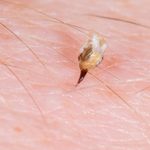Pavel-Krasensky/Shutterstock
6. Bed bugs
“Bedbug bites typically appear as ‘breakfast, lunch, and dinner’ lesions,” notes Joshua Zeichner, MD, director of cosmetic and clinical research in Dermatology at Mount Sinai Hospital in New York City. What that means is bed bugs typically bite the skin and then move on before biting again, leaving a linear distribution of bites. “The bites typically occur on the arms and the legs, as this is the skin exposed to the bed where the bugs have infested,” says Dr. Zeichner.
How to treat bed bug bites: Luckily, bed bug bites will go away on their own after a few days. If the urge to scratch drives you crazy, Dr. Zeichner recommends using an over-the-counter hydrocortisone ointment to reduce inflammation and itch.
7. Chiggers
You’re not likely to see these little biters but you’ll feel them later. Chiggers are not considered insects, but are actually members of the arachnid family, which includes ticks and spiders. They don’t fly, but that doesn’t stop them from biting you if you’re around grassy areas, a golf course, a baseball field, or a playground. Oddly enough, it’s only the baby chiggers that bite—or shall we say teethe—on your skin. They crawl on your clothing until they find an open area of skin and then it’s chomping time. “Chigger bites leave behind reddish bumps, with a brighter red dot in the center of each bump. These bumps also resemble pimples or hives,” says Angela Lamb, MD, director of the Westside Mount Sinai Dermatology Faculty Practice in New York City and an associate professor of dermatology.
How to treat chigger bites: To get relief, Dr. Lamb recommends taking a cool shower or washing the bite with soap and water. “To relieve the symptoms of itching or burning, I recommend applying cortisone cream or a topical treatment like After Bite, which uses a mix of soothing ingredients to relieve itch. For kids—and adults with sensitive skin—I recommend using After Bite Kids, a gentle, non-stinging cream that provides instant relief for symptoms of discomfort.”
Sharon-Keating/Shutterstock
8. Black widow spider
Found in warm dry areas of the southern and western United States, the black widow has a distinctive red hourglass shape on its abdomen. Shy and fond of dark corners, the black widow delivers a bite that is immediately painful. You’ll have swelling and redness at the site and you may see two fang marks when you identify bug bites from these spiders. Within eight hours, your muscles may become stiff, and you could experience nausea, dizziness, difficulty breathing, rash, itching, tremors, and leg paralysis.
How to treat a black widow spider bite: If a child has been bitten, get to the ER quickly as the spiders can be fatal to young ones. You can wash the area with cold water and soap and then ice for 10 minutes on and 10 minutes off until you get medical attention.






























